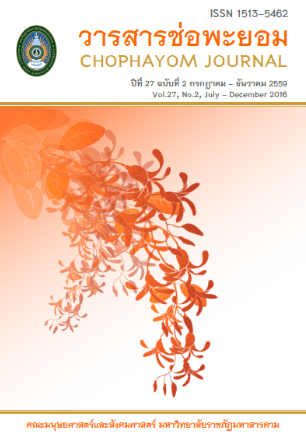Study of the Use of Grammatical Cohesive Devices inSawasdee Magazine Articles and Their Thai Translations
Abstract
บทคัดย่อ
งานวิจัยนี้มีวัตถุประสงค์เพื่อศึกษาประเภทของลักษณะวจนะสัมพันธ์ (cohesion) ในรูปแบบการเชื่อมโยงโครงสร้างทางไวยากรณ์ (grammatical cohesion) และศึกษาเปรียบเทียบความเหมือนและความต่างของการใช้ตัวเชื่อมโยงความในบทความภาษาอังกฤษและภาษาไทย กลุ่มตัวอย่างที่ใช้ในการศึกษานี้ คือ บทความภาษาอังกฤษและบทแปลภาษาไทยจากนิตยสาร สวัสดี ตามวิธีการของ Halliday and Hasan (1976) ผู้วิจัยใช้โปรแกรม Microsoft Excel 2010 วิเคราะห์ข้อมูลอัตราความถี่ (ร้อยละ) ของประเภทรูปแบบการเชื่อมโยงโครงสร้างทางไวยากรณ์แต่ละประเภท และนำมาศึกษาเปรียบเทียบลักษณะการใช้ตัวเชื่อมโยงความทั้งในบทความภาษาอังกฤษและบทแปลภาษาไทยเพื่อให้เห็นถึงความเหมือนและความต่างผลการวิจัยพบว่า บทความภาษาอังกฤษใช้การเชื่อมโยงความโดยการอ้างถึง (reference) มากที่สุด และ บทแปลภาษาไทยมีอัตราความถี่การใช้การเชื่อมโยงความโดยการใช้คำเชื่อม (conjunction) ปรากฏมากที่สุด ขณะที่มีการใช้หน่วยแทน(substitution) น้อยที่สุดทั้งในบทความภาษาอังกฤษและบทแปลภาษาไทย เมื่อเปรียบเทียมการเชื่อมโยงโครงสร้างไวยากรณ์ทั้งบทความภาษาอังกฤษและบทแปลภาษาไทย พบว่า มีทั้งความเหมือนและความต่างอันเป็นผลมาจากความต่างทางด้านไวยากรณ์
ABSTRACT
The study aims to explore the types of English and Thai grammatical cohesive devices and analyze the similarities and differences between English and Thai grammatical cohesive devices used in the articles. Ten English articles and their Thai translations from Sawasdeein-flight magazine were analyzed by using Halliday and Hasan’s (1976) framework of cohesion. All the identified grammatical cohesive devices in the sample texts were categorized and the occurrence frequencies of the grammatical cohesive devices were calculated by Microsoft Excel 2010 program. The similarities and differences between English and Thai grammatical cohesive devices were analyzed.
The findings reveal that reference is the most common used cohesive device in English texts, and conjunction is the most preferable grammatical cohesive device in Thai, while substitution is least frequently used among the four types of grammatical cohesion in both languages. Both English texts and Thai texts share both similarities and differences in some aspects due to the effect of grammatical features.






